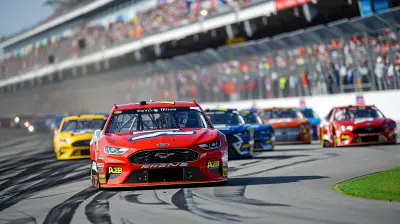Exploring the World Through Iconic Sports Stadiums
31 October 2025
When you think of sports, you probably picture the athletes, the roar of the crowd, or that nail-biting final moment. But let’s take a step back — literally — and look at where all the magic happens: sports stadiums. These grand arenas aren’t just places for games; they’re living, breathing landmarks packed with history, emotion, and cultural significance.
Welcome to the ultimate adventure of exploring the world through iconic sports stadiums. Buckle up, sports fans — this is gonna be fun.![]()
Why Stadiums Matter More Than You Think
Let’s be real: watching a match on TV is awesome, but being in the stadium? Whole different vibe. That first step into the arena, the chants echoing around you, the smell of street food floating through the air — it's goosebumps territory.Stadiums are much more than concrete and turf. They're where dreams are made, where underdogs become legends, and where fans from every corner of the globe come together as one.
They’re modern-day colosseums — only instead of gladiators, it’s Messi, LeBron, or Serena taking center stage.![]()
The Meccas of Modern Sports: Must-Visit Stadiums Around the Globe
Let’s jet around the world to check out some of the most iconic, jaw-dropping, and downright legendary sports stadiums you’ve got to see (and feel) to believe.1. Camp Nou – Barcelona, Spain 🇪🇸
If football had a cathedral, this would be it.Camp Nou — home of FC Barcelona — isn’t just the largest stadium in Europe; it’s also a monument to the beautiful game. With a seating capacity of nearly 100,000, the atmosphere during El Clásico (when Barcelona faces Real Madrid) is nothing short of electric.
Pro tip if you go: the museum tour is unreal. You’ll catch glimpses of Messi’s boots, historic trophies, and decades of football magic.
2. Madison Square Garden – New York City, USA 🇺🇸
You can't talk about iconic without mentioning "The Garden."From basketball games to boxing matches to sold-out concerts, Madison Square Garden is the grand stage where legends are born. Home to the New York Knicks and Rangers, it's as much a cultural hub as it is a sports venue.
It's kind of like Times Square — but louder and sweatier (in the best way).
3. Wembley Stadium – London, UK 🇬🇧
Wembley is more than just a football stadium; it’s a symbol of national pride.This iconic venue is where England won the 1966 World Cup, and it regularly hosts everything from the FA Cup finals to chart-topping concerts. The 133-meter-high Wembley Arch? You can see it from almost across the city — it's that iconic.
Wembley is where history repeats itself. In the most epic way possible.
4. Maracanã – Rio de Janeiro, Brazil 🇧🇷
Welcome to the heart of samba football.Maracanã embodies the soul of Brazilian football — dancing crowds, booming drums, and some of the greatest players in history. Remember the 2014 World Cup Final? Yep, that happened here.
This is where football meets carnival, and every match feels like a celebration.
5. Melbourne Cricket Ground (MCG) – Melbourne, Australia 🇦🇺
Cricket might not be everyone's cup of tea, but at the MCG, it’s the lifeblood of Aussie sports culture.This behemoth holds over 100,000 fans and hosts iconic events like The Ashes, the Boxing Day Test, and the AFL Grand Final. It’s part stadium, part national treasure.
Visiting the MCG is like stepping inside a living museum of Australian sports heritage.
6. Allianz Arena – Munich, Germany 🇩🇪
Let’s talk about ultramodern brilliance.Allianz Arena, the home turf of Bayern Munich, is sleek, futuristic, and the first stadium in the world with a full color-changing exterior. At night, it literally glows red like a beacon for football lovers.
It’s like a spaceship landed in the heart of Germany — and then started hosting football matches.
7. Yankee Stadium – New York City, USA 🇺🇸
Baseball fans, this one’s for you.Yankee Stadium is holy ground for Major League Baseball, and a symbol of American sports history. Ruth, Mantle, Jeter — all legends who’ve graced this field. The new stadium, rebuilt in 2009, still pays homage to its storied past.
Hot dogs, peanuts, and history — what more could you ask for?
8. Tokyo Dome – Tokyo, Japan 🇯🇵
Nicknamed "The Big Egg," this is Japan’s ultimate multi-purpose venue.It’s the home of the Yomiuri Giants (think: Japan’s version of the Yankees), but also hosts American football, concerts, pro wrestling, and even monster truck rallies. Talk about versatile!
Stepping into the Tokyo Dome feels like diving into Japan’s energetic pop-sports culture.![]()
Stadiums as Cultural Touchstones
You might be wondering — why are these stadiums so emotionally powerful?It’s not just about the games played there. Stadiums often represent the spirit of the cities they live in. They’re theaters of triumph and heartbreak, where community and passion collide in the most colorful ways.
Think about it: would a city like Barcelona even feel the same without Camp Nou? Could you picture New York without the roar of The Garden?
These cathedrals of sport aren't just buildings — they’re beating hearts of culture.![]()
Behind the Scenes: The Magic That Fans Don’t See
Here’s the kicker — a lot happens behind the scenes of these massive venues that fans rarely think about.- Thousands of workers keep things running — from groundskeepers to food vendors to security staff.
- Massive logistics are involved in flipping a stadium from football to concert mode overnight.
- Stadium design is a science now, ensuring perfect sightlines, acoustics, and even airflow to enhance the experience.
Stadiums are basically mini-cities — and running one is like hosting a party for tens of thousands of people… every week.
Want to Visit These Stadiums in Real Life? Here's How!
Alright, wanderlust kicking in yet? Yeah, same here.Visiting these stadiums doesn’t have to be a pipe dream. Most offer incredible guided tours, letting you walk through locker rooms, player tunnels, and VIP boxes. Some even let you step on the actual field — talk about bucket list material.
If you plan your trip around big matches, you’ll get the full, spine-tingling experience. But even off-season, the guided tours are rich with storytelling, history, and Instagram-worthy views.
The Rise of Tech-Driven, Sustainable Stadiums
Here’s something cool — stadiums are getting smarter and greener.From solar panels and rainwater recycling to contactless ticketing and AR-enhanced fan experiences, the new era of stadiums is all about innovation. The upcoming arenas in Qatar, for example, were designed with environmental sustainability in mind.
We’re talking about sports meets Silicon Valley — and it’s as cool as it sounds.
Imagine a World Without Stadiums…
Try to picture sports without stadiums. Weird, right?Without these iconic venues, would rivalries feel as intense? Would players perform the same without tens of thousands cheering them on (or booing)? Would cities lose a part of their soul?
Honestly, a stadium-less world feels flat — like a song without a beat.
Final Whistle: It’s More Than Just a Seat in the Stands
So, what did we learn from our whirlwind tour of the globe's most iconic sports stadiums?They're more than stone and steel. They’re emotional landscapes, landmarks of memory, and communal centers where stories are told with sweat, tears, and high-fives.
Next time you're in the stands, take a moment. Soak it in. You’re not just watching a game — you’re witnessing modern history unfold, one cheer at a time.
So get out there, grab some tickets, and start checking these stadiums off your bucket list. Your passport — and your sports-loving soul — will thank you.
all images in this post were generated using AI tools
Category:
Sports TravelAuthor:

Preston Wilkins

